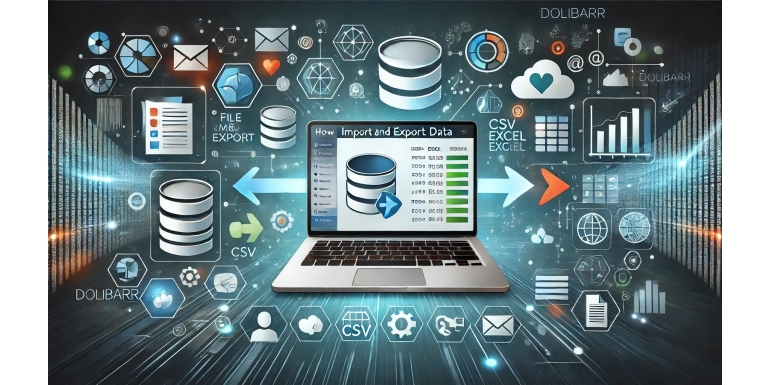
Introduction
Dolibarr is an open-source ERP and CRM software used by many businesses to manage their commercial, accounting, and logistical activities. Efficient data management is essential to ensure smooth operations. The ability to import and export data in Dolibarr is a key feature that allows companies to migrate their information, automate processes, and enhance resource management.
In this article, we will detail the methods and best practices to import and export data in Dolibarr efficiently, avoiding common mistakes and optimizing information management.
1. Why Import and Export Data in Dolibarr?
1.1. Importance of Data Management
Importing and exporting data allows businesses to:
-
Easily migrate their information from another ERP/CRM system.
-
Backup and secure important data.
-
Facilitate mass updates (e.g., updating product prices).
-
Save time by automating data integration.
1.2. Use Cases
Here are some specific cases where data import/export is necessary:
-
System migration: When a company transitions to Dolibarr from another ERP.
-
Mass updates: Bulk modifications of prices, stock levels, or customer contacts.
-
Integration with other tools: Synchronization with an e-commerce platform, accounting software, or reporting tools.
2. How to Import Data into Dolibarr?
2.1. Supported Formats
Dolibarr allows data import in several formats:
-
CSV (comma-separated or semicolon-separated text format)
-
XML
-
JSON (for some APIs and third-party integrations)
2.2. Step-by-Step Import Process
-
Prepare the data:
-
Ensure columns are properly formatted.
-
Verify data consistency (e.g., avoiding duplicates).
-
Clean typographical errors or incorrect entries.
-
-
Access the Import Tool:
-
In Dolibarr, go to Tools > Import Assistant.
-
Select the type of data to import (clients, products, invoices, etc.).
-
-
Upload the File:
-
Choose the prepared CSV/XML file.
-
Map the file columns with Dolibarr fields.
-
Verify import options (add, update, remove duplicates).
-
-
Launch the Import and Check Results:
-
Analyze the import report.
-
Correct any errors and re-import if necessary.
-
2.3. Best Practices for a Successful Import
-
Always test with a small sample before performing a mass import.
-
Use clear and consistent column names.
-
Check date and number formats (e.g., European vs. American format).
-
Make backups before importing important files.
3. How to Export Data from Dolibarr?
3.1. Available Export Formats
Dolibarr allows data export in different formats:
-
CSV (widely used for analysis and integration with other tools).
-
Excel (XLS/XLSX) (convenient for data manipulation in Microsoft Office).
-
XML and JSON (ideal for API integrations and automated systems).
-
PDF (often used for exporting commercial documents such as invoices, quotes, and purchase orders).
3.2. Step-by-Step Export Process
-
Access the Export Tool:
-
Navigate to Tools > Export Assistant.
-
Choose the type of data to export (clients, products, invoices, orders, etc.).
-
-
Configure Export Settings:
-
Select the fields to include in the export.
-
Define filters if necessary (e.g., export only active clients).
-
Choose the output format (CSV, Excel, XML, JSON).
-
-
Generate and Download the File:
-
Verify the export before using it.
-
Test importing the exported file into another system to ensure compatibility.
-
3.3. Tips for an Efficient Export
-
Use filters to reduce file size and avoid unnecessary data.
-
Check CSV file encoding to prevent display issues (UTF-8 recommended).
-
Schedule automatic exports if regular updates are needed (e.g., synchronization with an e-commerce site).
4. Integration with Other Systems
4.1. Using APIs for Automated Import/Export
Dolibarr provides a REST API that enables the automation of import and export processes. This is particularly useful for:
-
Synchronizing an e-commerce site with Dolibarr.
-
Automating stock or order updates.
-
Connecting Dolibarr with third-party tools such as CRMs or accounting software.
4.2. Automating Tasks with Scripts
Advanced users can use Python or PHP scripts to automatically extract and import data by querying the Dolibarr database or using the REST API.
4.3. Connectors and Add-on Modules
Several Dolibarr modules available on Dolistore facilitate integration with other software, such as Prestashop, WooCommerce, QuickBooks, and Zapier.
Conclusion
The ability to import and export data in Dolibarr is essential for effective information management. Whether for migrating data, automating updates, or synchronizing Dolibarr with other tools, adopting best practices is key to avoiding errors and optimizing performance.
By following these guidelines, you can manage your Dolibarr data with greater precision and efficiency while ensuring better integration with your other management systems.
